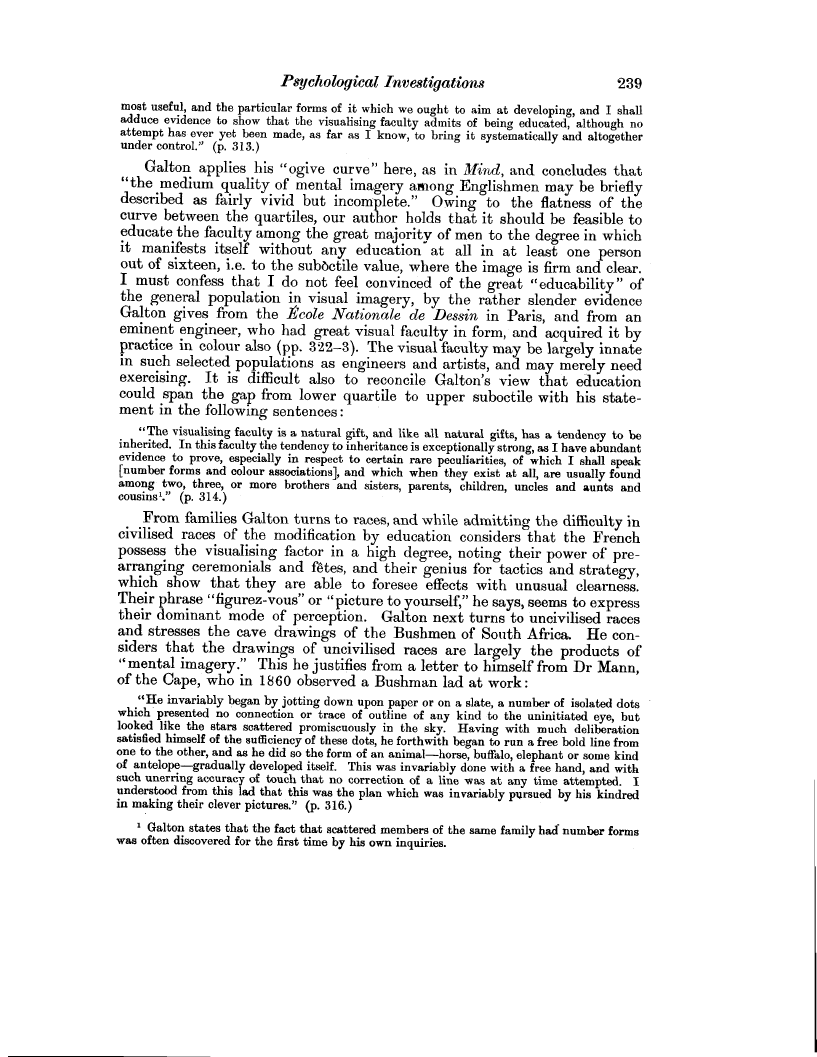Psychological Investigations 239
most useful, and the particular forms of it which we ought to aim at developing, and I shall adduce evidence to show that the visualising faculty admits of being educated, although no attempt has ever yet been made, as far as I know, to bring it systematically and altogether
under control." (p. 313.)
Galton applies his "ogive curve" here, as in Mind, and concludes that "the medium quality of mental imagery among Englishmen may be briefly described as fairly vivid but incomplete." Owing to the flatness of the curve between the quartiles, our author holds that it should be feasible to educate the faculty among the great majority of men to the degree in which it manifests itself without any education at all in at least one person out of sixteen, i.e. to the suboctile value, where the image is firm and clear. I must confess that I do not feel convinced of the great "educability" of the general population in visual imagery, by the rather slender evidence Galton gives from the - sole Nationale de Dessin in Paris, and from an eminent engineer, who had great visual faculty in form, and acquired it by practice in colour also (pp. 322-3). The visual faculty may be largely innate in such selected populations as engineers and artists, and may merely need exercising. It is difficult also to reconcile Galton's view that education could span the gap from lower quartile to upper suboctile with his statement in the following sentences
"The visualising faculty is a natural gift, and like all natural gifts, has a tendency to be inherited. In this faculty the tendency to inheritance is exceptionally strong, as I have abundant evidence to prove, especially in respect to certain rare peculiarities, of which I shall speak
[number forms and colour associations], and which when they exist at all, are usually found among two, three, or more brothers and sisters, parents, children, uncles and aunts and cousins'." (p. 314.)
From families Galton turns to races, and while admitting the difficulty in civilised races of the modification by education considers that the French possess the visualising factor in a high degree, noting their power of prearranging ceremonials and fetes, and their genius for tactics and strategy, which show that they are able to foresee effects with unusual clearness. Their phrase "figurez-vous" or "picture to yourself," he says, seems to express their dominant mode of perception. Galton next turns to uncivilised races and stresses the cave drawings of the Bushmen of South Africa. He considers that the drawings of uncivilised races are largely the products of "mental imagery." This he justifies from a letter to himself from Dr Mann, of the Cape, who in 1860 observed a Bushman lad at work:
"He invariably began by jotting down upon paper or on a slate, a number of isolated dots which presented no connection or trace of outline of any kind to the uninitiated eye, but looked like the stars scattered promiscuously in the sky. Having with much deliberation satisfied himself of the sufficiency of these dots, he forthwith began to run a free bold line from one to the other, and as he did so the form of an animal-horse, buffalo, elephant or some kind of antelope-gradually developed itself. This was invariably done with a free hand, and with such unerring accuracy of touch that no correction of a line was at any time attempted. I understood from this lad that this was the plan which was invariably pursued by his kindred
in making their clever pictures." (p. 316.)
1 Galton states that the fact that scattered members of the same family had number forms was often discovered for the first time by his own inquiries.

